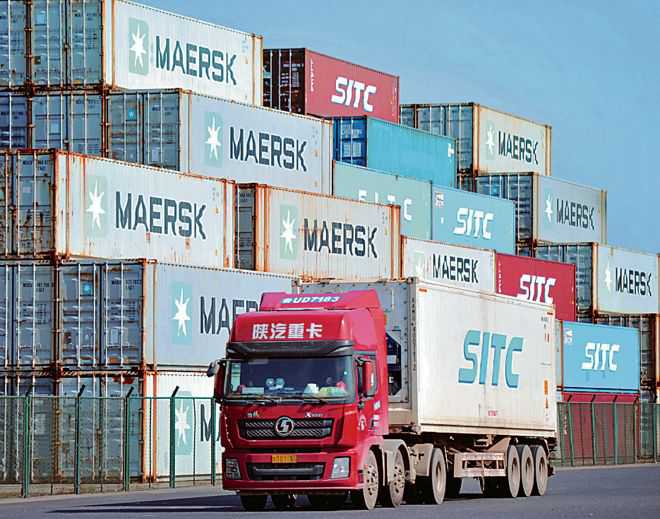
Formidable: China subsidises its exports and its financial architecture supports export production massively. China is India’s most important competitor.
Jayshree Sengupta
Senior fellow, Observer Research Foundation
THE recent one-on-one talks between Prime Minister Narendra Modi and Chinese President Xi Jinping at Mamallapuram on trade and investment had one tangible outcome. There will be a mechanism in place soon to study the problems pertaining to trade and investment between the two countries. It will be important to sort out various trade issues before India accepts the terms and conditions of the mega free trade treaty, the Regional Comprehensive Economic Partnership (RCEP), comprising 16 countries — 10 ASEAN nations plus China, Japan, India, South Korea, Australia and New Zealand. It will be the world’s biggest economic bloc, covering nearly half of the global economy, a little less than half of the world’s population, and accounting for 39 per cent of the world’s GDP. Joining it perhaps will give India an advantage to negotiate the terms and conditions from within. Many members of the deal are now quite impatient about completing the treaty by November 2019.
While it is true that most of the world trade is taking place within regional arrangements and Free Trade Agreements (FTAs), India must not be at a disadvantage in opening up to countries that are highly competitive; its most important competitor is China. India has to weigh carefully the gains to be had from signing the treaty, which may mean making itself vulnerable to having its markets inundated with Chinese goods.
The main advantage will be that India would be able to purchase its raw material and intermediate goods at concessional prices from other members under the mega FTA. On its own, if India has to purchase these goods in the international markets, these would cost much more. Intermediate goods are vital for making Indian exports competitive.
The other advantage which many economists are pointing out is that India has to integrate itself into the global value chains which produce parts of goods in different countries but are assembled in a host country like China. The edge lies in being able to enter into a chain of global orders by multinational corporations to developing countries to produce goods that are sold internationally under well-known brand names. Most of the countries to our East are participating in the global value chains and reaping the benefits of an increase in income and employment.
The treaty may also lead to more FDI inflows from member countries, now that the government has reduced the corporate tax rates. FDI can create jobs and rev up exports and reverse the economic slowdown.
In the recent past, however, according to a research paper by Niti Aayog, India’s numerous FTAs with regional partners have not yielded positive results. In most cases, the FTAs have been followed by an increase in imports from the partner country; India has trade deficits with 13 member countries of the RCEP. The India-ASEAN FTA has led to a bigger trade deficit than before. With South Korea, Japan and Thailand, too, there have been similar results. The surge in imports takes place as soon as the FTA is concluded, but a similar thrust in exports is missing. The auto trigger mechanism of higher tariffs proposed by India to check the sudden surge in imports may be ineffective due to lack of monitoring infrastructure. Slack export production in India is due to lack of competitiveness in today’s world, as shown by the World Economic Forum’s Global Competitiveness Index on which India has slipped 10 places to the 68th rank.
We are losing out to our neighbouring countries due to higher logistics costs and lack of proper port facilities that lead to higher turnaround time for ships. Indian companies’ labour costs are high because India is not resorting to sweatshop wages. On the whole, in terms of quality and price, we seem to be lagging behind our neighbours and that is why foreign firms leaving Chinese shores due to the US-China trade war and an increase in tariffs are not coming to India. Also, industrial growth was only 1.1 per cent in August.
India has an advantage in services exports and has demanded freer movement of its service personnel within the RCEP and data localisation. This will give a boost to our services exports despite the language barrier. This demand has not been accepted by the RCEP so far. All that the treaty wants India to do is to reduce its tariff lines on 80 to 90 per cent of imported goods. Reducing tariffs on almost all imports would be like an open invitation to all 15 members to flood Indian markets with their goods. India is not able to compete with China on many items and New Zealand in dairy; it is this lack of competitiveness which has led to greater unpreparedness for India.
First and foremost, India has to improve its industrial growth rapidly which may not be easy, given our creaky infrastructure, shortage of skilled labour and complex bureaucracy. For all RCEP members, except China, the domestic market is small and hence, they need to expand exports and
are doing so aggressively. China subsidises its exports and its financial architecture supports export production massively. Being an authoritarian state, it has a smoother bureaucracy and there is little scope for disruptions in production. That is how China has become the world’s biggest exporter.
China has to give more access to Indian exports, especially of pharmaceuticals and agricultural products. Hopefully, the Modi-Xi meeting will lead to addressing the reasons for India’s ballooning trade deficit of $53 billion in 2018-19. There are too many non-tariff barriers in place in China which have to be removed, which could lead to more investment flows between the two countries. Otherwise, progressively low tariff rates which form the core of the RCEP treaty, will seriously hurt our dairy, steel, MSME and textile sectors.



























